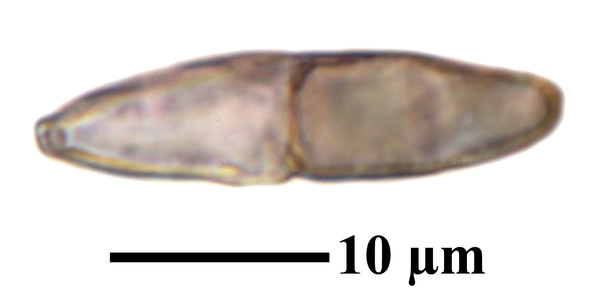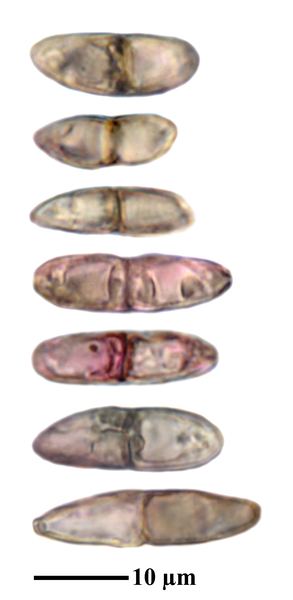Mycomicrothelia inaequalis (Fabre) D. Hawksw.
Bot. J. Linn. Soc., 82: 55, 1981. Basionym: Amphisphaeria inaequalis Fabre - Ann Sci. Nat., Bot., sér. 6, 9: 85, 1879 (1878)
Synonyms: Astrosphaeriella inaequalis (Fabre) Scheinpflug; Kirschsteiniella inaequalis (Fabre) Petr.; Microthelia inaequalis (Fabre) E. Müll.
Distribution:
Description: Thallus crustose, mostly endosubstratic and poorly evident, not lichenized. Perithecia black, scattered, 0.2-0.3 mm across, with a dark reddish brown to almost black involucrellum reacting K+ olive-green, mainly 60-100 µm thick, confluent with exciple, extending laterally and forming a distinct, conspicuous, up to 0.35 mm wide, greenish-black fringe around the perithecium, formed of incorporated bark cells and radially oriented, mainly 3-4 µm thick, ± smooth-walled cells similar to those of the basal fringe with which it is continuous. Exciple often poorly developed in lower part, 5-10 µm thick, composed of 3-6 layers of c. 2 µm thick, interwoven hyphae, mainly subhyaline but becoming brownish in uppermost parts, continuous below the centrum. Hamathecium of numerous, branched and anastomosing, filiform, 1.5-2.5 µm thick, septate pseudoparaphyses; hymenial gel I-. Asci 8-spored, elongate-clavate, with two functional wall layers, fissitunicate, with an internal apical beak, K/I-. Ascospores, 1-septate, moderately constricted at septum, brown, broadly ellipsoid, the lower cell consistently somewhat smaller, 18-22 x (7-)8.5-11 µm, the wall apparently smooth, often with a c. 1 µm thick gelatinous sheath swelling in K. Pycnidia unknown. Photobiont: absent. Spot tests: K-, C-, KC-, P-, UV-. Chemistry: without lichen substances.Note: a non-lichenized fungus growing on wood of Olea, known from Southern France; to be looked for in Mediterranean Italy.
Growth form: Fungus
Substrata: bark and lignum
Reproductive strategy: mainly sexual
Poorly known taxon in need of further study
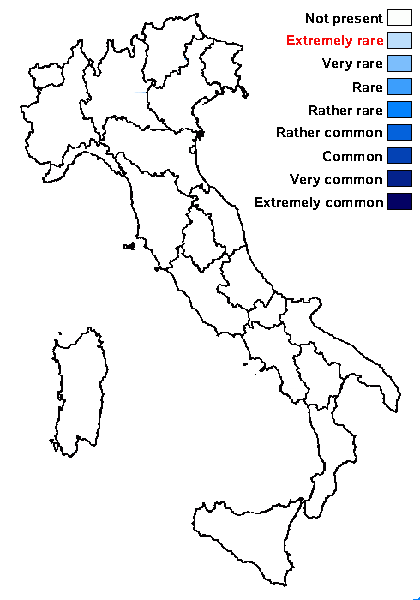
Predictive model


Felix Schumm - CC BY-SA 4.0
[Ratcliff], USA, Georgia, Glynn Co., on Smilax laurifolia. Leg. Ratcliff, 12.1941, det. A. Aptroot.
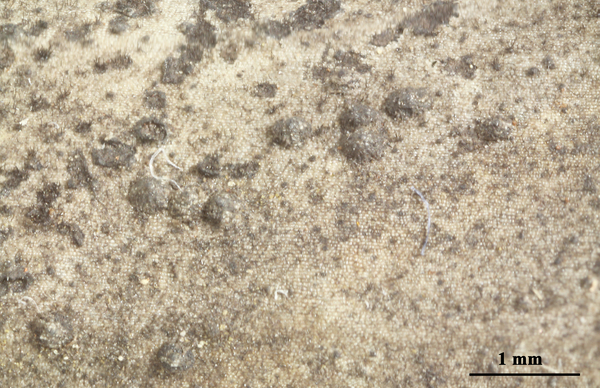

Felix Schumm - CC BY-SA 4.0
[Ratcliff], USA, Georgia, Glynn Co., on Smilax laurifolia. Leg. Ratcliff, 12.1941, det. A. Aptroot.
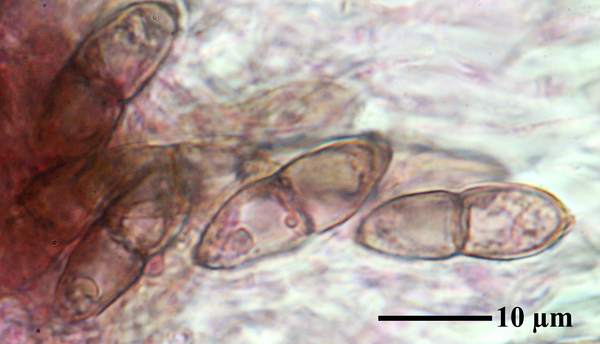

Felix Schumm - CC BY-SA 4.0
[Ratcliff], USA, Georgia, Glynn Co., on Smilax laurifolia. Leg. Ratcliff, 12.1941, det. A. Aptroot.
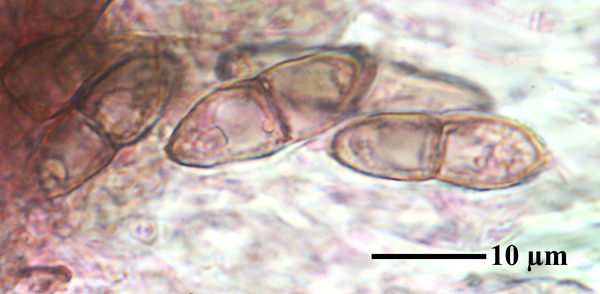

Felix Schumm - CC BY-SA 4.0
[Ratcliff], USA, Georgia, Glynn Co., on Smilax laurifolia. Leg. Ratcliff, 12.1941, det. A. Aptroot.


Felix Schumm - CC BY-SA 4.0
[Ratcliff], USA, Georgia, Glynn Co., on Smilax laurifolia. Leg. Ratcliff, 12.1941, det. A. Aptroot.
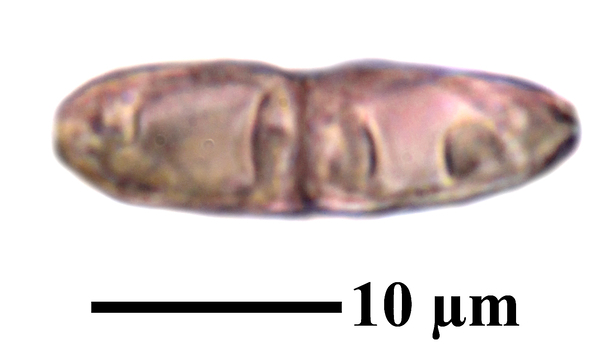

Felix Schumm - CC BY-SA 4.0
[Ratcliff], USA, Georgia, Glynn Co., on Smilax laurifolia. Leg. Ratcliff, 12.1941, det. A. Aptroot.
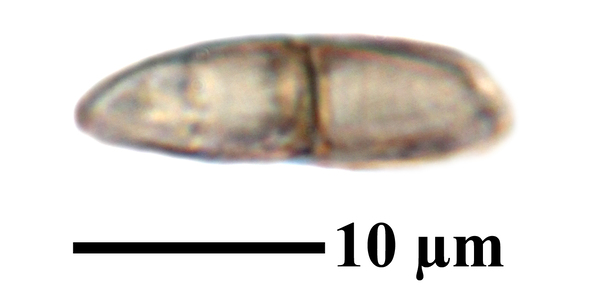

Felix Schumm - CC BY-SA 4.0
[Ratcliff], USA, Georgia, Glynn Co., on Smilax laurifolia. Leg. Ratcliff, 12.1941, det. A. Aptroot.


Felix Schumm - CC BY-SA 4.0
[Ratcliff], USA, Georgia, Glynn Co., on Smilax laurifolia. Leg. Ratcliff, 12.1941, det. A. Aptroot.
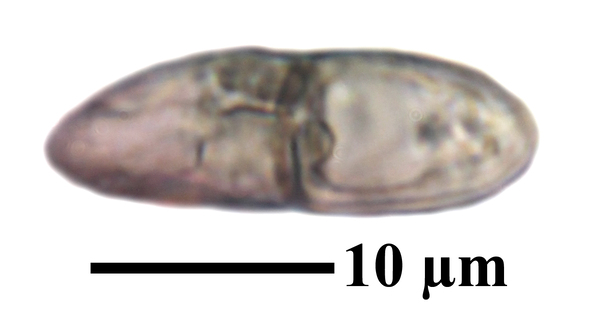

Felix Schumm - CC BY-SA 4.0
[Ratcliff], USA, Georgia, Glynn Co., on Smilax laurifolia. Leg. Ratcliff, 12.1941, det. A. Aptroot.
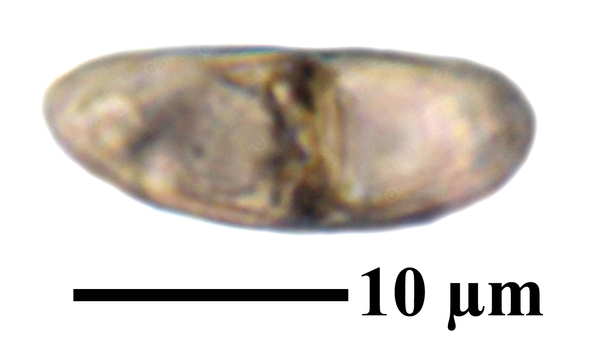

Felix Schumm - CC BY-SA 4.0
[Ratcliff], USA, Georgia, Glynn Co., on Smilax laurifolia. Leg. Ratcliff, 12.1941, det. A. Aptroot.
Growth form: Fungus
Substrata: bark and lignum
Reproductive strategy: mainly sexual
Poorly known taxon in need of further study

Predictive model


Felix Schumm - CC BY-SA 4.0
[Ratcliff], USA, Georgia, Glynn Co., on Smilax laurifolia. Leg. Ratcliff, 12.1941, det. A. Aptroot.


Felix Schumm - CC BY-SA 4.0
[Ratcliff], USA, Georgia, Glynn Co., on Smilax laurifolia. Leg. Ratcliff, 12.1941, det. A. Aptroot.


Felix Schumm - CC BY-SA 4.0
[Ratcliff], USA, Georgia, Glynn Co., on Smilax laurifolia. Leg. Ratcliff, 12.1941, det. A. Aptroot.


Felix Schumm - CC BY-SA 4.0
[Ratcliff], USA, Georgia, Glynn Co., on Smilax laurifolia. Leg. Ratcliff, 12.1941, det. A. Aptroot.


Felix Schumm - CC BY-SA 4.0
[Ratcliff], USA, Georgia, Glynn Co., on Smilax laurifolia. Leg. Ratcliff, 12.1941, det. A. Aptroot.


Felix Schumm - CC BY-SA 4.0
[Ratcliff], USA, Georgia, Glynn Co., on Smilax laurifolia. Leg. Ratcliff, 12.1941, det. A. Aptroot.


Felix Schumm - CC BY-SA 4.0
[Ratcliff], USA, Georgia, Glynn Co., on Smilax laurifolia. Leg. Ratcliff, 12.1941, det. A. Aptroot.


Felix Schumm - CC BY-SA 4.0
[Ratcliff], USA, Georgia, Glynn Co., on Smilax laurifolia. Leg. Ratcliff, 12.1941, det. A. Aptroot.


Felix Schumm - CC BY-SA 4.0
[Ratcliff], USA, Georgia, Glynn Co., on Smilax laurifolia. Leg. Ratcliff, 12.1941, det. A. Aptroot.


 INDEX FUNGORUM
INDEX FUNGORUM
 GBIF
GBIF
